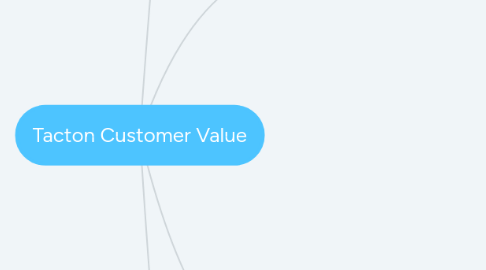
1. Revenue growth
1.1. Higher sales volumes
1.1.1. Higher volumes of quality leads
1.1.1.1. Lead Generation
1.1.2. Higher volumes of addressed opportunities
1.1.2.1. Needs-based user interaction
1.1.2.2. Automation of quote documents
1.1.2.3. Partner Empowerment
1.1.2.4. Customer Self-service
1.1.3. Increased hit rate for each opportunity
1.1.3.1. Decreased response time for quotes
1.1.3.1.1. Needs-based user interaction
1.1.3.1.2. Automation of quote documents
1.1.3.1.3. Proposal Collaboration
1.1.3.2. Better look & quality of proposals
1.1.3.2.1. Automation of quote documents
1.1.3.2.2. Visualization
1.1.3.2.3. Design Automation
1.1.4. Enablement of omni-channel sales
1.1.4.1. Partner Empowerment
1.1.4.2. Customer Self-service
1.1.5. Approaching new/emerging tech markets
1.1.5.1. Management of continuously evolving product
1.1.5.1.1. Separation of product logic and data
1.1.5.1.2. Integration to PLM
1.1.6. Approaching new geographical markets
1.1.6.1. Enablement of regional offices
1.1.6.1.1. Needs-based user interaction
1.1.6.1.2. Automation of quote documents
1.1.6.2. Partner Empowerment
1.1.6.3. Customer Self-service
1.2. Higher sales margins
1.2.1. Enforcing sales price
1.2.1.1. Pricing execution
1.2.1.2. Pricing optimization
1.2.1.3. Commercial approvals
1.3. Higher order value
1.3.1. Better product fit
1.3.1.1. Needs-based user interaction
1.3.1.2. Technical approvals
1.3.2. Better product mix
1.3.2.1. Solution optimisation
1.4. Shorter time-to-volume
1.4.1. Separation of product logic and data
1.4.2. Needs-based user interaction
1.5. Shorter time-to-market
1.5.1. Separation of product logic and data
1.5.2. Needs-based user interaction
2. People efficiency
2.1. Reduced number of sales & sales support employees
2.1.1. Faster and more accurate capturing of customer requirements
2.1.1.1. Needs-based user interaction
2.1.1.2. Visualization
2.1.1.3. Design Automation
2.1.2. Faster and more accurate generation of proposal & quotes
2.1.2.1. Automation of quote documents
2.1.2.2. Automation of price calculations
2.1.2.3. Proposal collaboration
2.1.3. Enablement of omni-channels sales
2.1.3.1. Partner Empowerment
2.1.3.2. Customer Self-service
2.2. Reduced sales & sales support salary & training cost
2.2.1. Reduced competence requirements
2.2.1.1. Needs-based user interaction
2.2.1.2. Automation of quote documents
3. Order quality
3.1. Order management & change cost savings (order processing)
3.1.1. One source of truth for post-order change
3.1.1.1. Higher quality and detail of order entry items
3.1.1.2. Separation of product logic and data
3.1.1.3. Needs-based user interaction
3.1.2. One source of truth for post-order ETO requests
3.1.2.1. Technical approvals
3.1.3. Reduced number of employees focused on order QA & order processing
3.1.3.1. Integration to ERP
3.1.3.2. Higher quality and detail of order entry items
3.2. Order error cost savings (manufacturing)
3.2.1. Fewer malfunctioning solutions
3.2.1.1. Higher quality and detail of order entry items
3.2.2. Transformation from ETO (project) to CTO (product) organisation
3.2.2.1. API for Analytics
3.3. Claims & warranty cost savings (installation)
3.3.1. Fewer wrong deliveries
3.3.1.1. Needs-based user interaction
3.3.1.2. Visualization
3.3.1.3. Design Automation
3.3.2. Fewer malfunctioning deliveries
3.3.2.1. Higher quality and detail of order entry items
4. Maintenance efficiency
4.1. Minimizes time required to setup and maintain the product data, logic and UI available to the end-users.
4.1.1. Engine: Configurator
4.1.1.1. # Non-sequential solver Rules can be added one and one and the order of the rules does not matter Possible to implement complete solution gradually The user defines the data and dependencies, the solver finds the optimal solution Everything you need to know is already available
4.1.1.2. # Powerful rules language (constraints) Rules are written in the same way engineers think about them - Design rules can easily be validated by anyone - Coding knowledge NOT required The rules are not written on the component but to attributes on the components - Data and rules (logic) is totally separated (easy daily update of data) - The number of rules is a fraction compared to similar solutions
4.1.1.3. # Interactive testing and debugging environment Shows which values that are compatible with previous inputs Automatic advice on how to resolve conflicts
4.2. Minimizes knowledge required to setup and maintain the product data, logic and UI available to the end-users.
4.2.1. Engine: Configurator
4.2.1.1. Separation of logic and data: By enabling engineering to add and remove new variants of components to the solution without updating logic affecting the same components.
4.2.1.2. # Powerful rules language (constraints) Rules are written in the same way engineers think about them - Design rules can easily be validated by anyone - Coding knowledge NOT required The rules are not written on the component but to attributes on the components - Data and rules (logic) is totally separated (easy daily update of data) - The number of rules is a fraction compared to similar solutions
